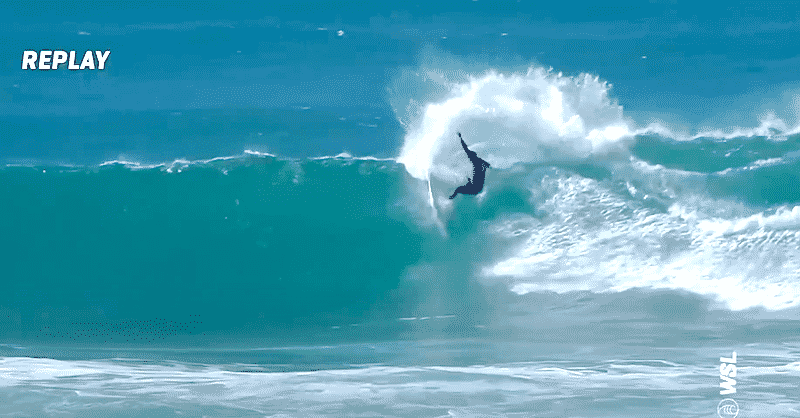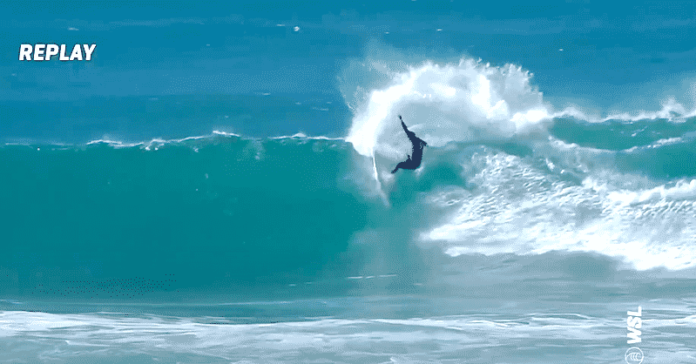
“Despite what the majority of surf media would have you believe, Kelly Slater is not the GOAT across all sports. In fact, he’s not even close.”
Kelly Slater is an outlier in the history of professional sports. His latest victory at Pipeline came just shy of his fiftieth birthday and he’s had victories in the top tier of professional surfing over three decades.
As the holder of eleven world titles and numerous competitive records, he surely deserves to be in the conversation about the greatest athletes of all time.
But it’s a very short conversation.
Despite what the majority of surf media would have you believe, Kelly Slater is not the GOAT across all sports. In fact, he’s not even close.
1. The Surfing As Sport Problem
Outright dismissal of Kelly Slater from the conversation might seem harsh, but the problem is not so much with Slater as an athlete, but with surfing as a sport.
I’m sure some surfers reading this might baulk at that last sentence. Surfing? A sport? Don’t be ridiculous.
We might debate the definition of “sport”, but if your definition involves clear and objective targets and competition as a fundamental element of performance, then surfing is somewhat lacking.
This uncertainty about surfing as a viable competitive activity is borne out by the number of surfers who actually care about pro surfing, or even acknowledge its existence.
The most respected magazine in the industry (and, crucially, one of the few still surviving), The Surfer’s Journal, has traditionally ignored this element altogether.
The online viewing figures for the WCT, the elite level of competition surfing, are a fraction of the audiences for the likes of curling or kabaddi.
Darts makes it look like a joke. The number of fans on the beach would embarrass an average Highland League football team.
Recent Olympic inclusion gives surfing some credibility, but most surfers probably couldn’t name the two governing bodies for competition.
The flashier WSL has tended to be seen as the bellwether of high-performance surfing, but the majority of surfers neither care for that style of surfing nor want to replicate it.
The scoring is subjective, controversial and forever flawed. At the best of times no-one can decide who the best surfer in the world is, or how we might make that decision. Even the most hardcore of pro surf fans are thoroughly fed up.
But mostly no-one really cares.
If not for the generosity of billionaire Dirk Ziff, who appears to be financing the show out of charity at this stage, it might have vanished like spit from a tube long ago.
Surfing may well have exploded into a common, Instagrammable pastime, but as a sport it remains niche. Pro surfing is a bubble within a bubble.
Is Kelly Slater even the best surfer ever? We’ll never know.
2. The Accessibility and Diversity Problem
The GOAT of GOATS needs to come from a sport where the talent pool includes more or less everyone on the planet. If a sport isn’t cheap enough or accessible enough for everyone to try it, how do you know you’re the best in the world at it?
If the sport isn’t widely supported and understood, then how might we trust the quality of discourse?
GOATs need to come from sports that have no major barriers to entry. Sports that are globally accessible, simple and cheap. Sports with clear and unequivocal rules that allow us to define greatness.
The participation and fan base should transcend borders and cultures.
I’m thinking of things like boxing, football, basketball, running… If you conquer one of these you’re truly exceptional. There is no luck and circumstance involved. You’ve simply got more talent than everyone else or you’ve worked harder, and likely it’s a divine combination of both.
There are millions of people who would never be able to surf. It’s too expensive, too complicated, too dependent on specific geography and weather. It would be accurate to say that there are millions of people who’ve never even seen surfing beyond beginners flip-flapping on foam boards at a holiday beach.
If you want to get good at surfing you need access to good waves. The regions of the world with quality waves and affordable coastal properties are few and shrinking.
Even if you were lucky enough to be born into a situation that allowed you to surf regularly, you’re unlikely to progress without a strong local scene.
If we’re focusing on pro surfing, then you’ll need organised competitions to access. Beyond that still, if you want to get really good, then you need to travel extensively. All the time.
That’s a rare and specific set of circumstances.
A cursory look at the statistics of surfing’s world champions tells us there’s a narrow range of people who could ever get there, and it’s hardly related to how much talent you have.
Across both men’s and women’s divisions only five nationalities have ever won world titles. (I’m not including Martin Potter’s representation of the UK).
103 world titles have been awarded since professional surfing began: 51 for USA (inc Hawaii); 42 for Australia; 5 for Brazil; 3 for South Africa and 2 for Peru.
When it comes to world champions geographical fortune trumps talent.
Within these narrow regions surfing has a diversity problem. This would warrant further statistical analysis if it wasn’t so blatantly obvious. You might count the number of black professional surfers in history on one hand, and Michael February is the only one to reach the WCT.
Does that seem like broad enough competition for the Greatest Of All Time?
3. The Comparison Problem
Comparing sports for the purpose of GOAT arguments is fraught with problems, but if we do, surfing doesn’t exactly shine.
There’s the subjectivity and endless controversy about judging, for a start. For the sake of brevity I won’t dig into that too much, but suffice to say it’s a matter of conjecture or simply opinion as to what excellent surfing might look like.
At the highest level these judgements stray beyond subjective and into the realms of entirely arbitrary. Yet surfers are still scored on a scale of zero to ten points for each wave surfed, with often tenths and sometimes hundredths of a point separating winner from loser. Put your faith in that, if you will.
I’d place a lot more value in seeing a ball go into a net or someone crossing a line.
A common argument in surfing’s favour is how dynamic and athletic it is, and while this may be true in glimpses (when the waves are good) it’s hardly a consistent marker of competitive surfing performance.
If we compare the number of events in pro surfing and the time spent actually scoring points (or even actually surfing rather than just sitting waiting for waves) it looks a bit silly.
The format of competition has undergone various changes over the years, but the current schedule is eleven competitions in a year. If you make a final you’ll surf a maximum of six heats per event. Heat times vary, but let’s average them at thirty minutes. That’s three hours of surfing per competition, absolute maximum, and twelve scoring waves.
This might be a performance requirement best measured in seconds rather than minutes.
Kelly Slater has eleven world titles and fifty-five event wins. For argument’s sake let’s say 330 heat wins in the competitions where he’s been overall winner, 660 scoring waves, 165 hours of surfing.
Brazilian football legend Pele is listed by Guinness World Records as scoring 1279 goals in 1364 games. Granted, some of that wasn’t at the very highest level, but it’s still unbelievable consistency over 2046 hours of competitive football. (With no sitting on the pitch waiting for the ball, presumably).
An NBA season has 82 games in the regular season and a potential maximum of 28 games in the playoffs. Lebron James has played 1351 career games to date. (Not counting All Star or Olympic appearances).
Each game lasts an average of 2-2.5 hours, with 48 minutes of playing time. That’s 3040 hours of intense NBA basketball.
Players rarely play every minute, of course. Lebron is listed as having 51, 524 minutes on the court. He’s missed the playoffs just three times in his nineteen seasons (and counting). He’s played 94% of possible games in his career and never missed a playoff game.
People will point to Kelly’s longevity, and at fifty ears old it is remarkable to still be competing at the highest level, but in comparison to Lebron or Pele it looks like a bit of a joke.
Just for funsies, let’s look at Kelly Slater vs Phil “The Power” Taylor in darts.
Statistically, Taylor would smoke Kelly in many areas, not least the sixteen World Championship titles (including eight back-to-back) to Slater’s eleven.
But we can’t really compare darts as a sport to surfing, can we?
Athletically there’s no comparison, of course.
But anyone who’s tried to throw darts understands it’s not quite as easy as it looks. Imagine trying to throw in a world championship game, with hundreds of thousands of people watching on TV and a live crowd that’s not only vociferous and rowdy, but are just a couple of feet away from you, and more than a bit drunk.
Now imagine you’re also half-cut…
Looking at darts objectively, you could say that anyone, absolutely anyone, has the capacity to be the best in the world, right? The target never moves.
Surely it’s just about repetition? No-one on earth has an advantage over anyone else. It’s not only a sport that everyone can access, but a sport you can immediately play on an even field. You might be Phil Taylor or a child picking up darts for the first time, you play under exactly the same conditions.
Imagine what it takes to utterly dominate a sport like this.
And if we’re talking about popularity and viewing figures, well surfing’s a dim and distant loser to darts in that respect, too.
4. The Surf Media Problem
If you follow surf media (and, let’s face it, that pretty much means checking a couple of websites) you might recognise that some of the loudest and most respected voices in the industry belong to men who have a lot in common with Slater.
Surfing being the nepotistic little bubble that it is, many of these men also know Kelly on a personal level, if not as a friend, then certainly as someone with whom they’ve shared various interactions over thirty years.
Those adamant about Kelly’s GOAT status in the wider world can’t possibly look at this objectively. They have an emotional attachment to Slater, a man of their age, still doing stupendous things in the sport they love.
They’ve grown up with Kelly and witnessed everything he’s done, and as the years recede he becomes a symbol of hope for their own uncertain futures. If Kelly can still do it, then maybe we can, they surely think.
This isn’t a criticism of any of these people personally, it’s just recognition of the fact they have inherent bias accrued over a lifetime of love for surfing. You can’t blame them for that. But you can question their viewpoint.
Ultimately, Kelly Slater has done exceptional things in professional surfing, most of which might never be equaled. There’s no argument there. But anointing him as the greatest athlete of all time is indicative of surfing’s narrow view of the world.
Sport is just sport, at the end of the day. But as we know, in the most elevated and spectacular moments – the realms where GOATs play – it can be an awful lot more.
When we talk about those who are worthy of being called the GOAT, we should be talking about people whose sporting performances have transcended sport. We should be talking about figures who are globally recognised and historically remembered, people who are idolised by children and worthy of that status.
What has Kelly done for the world? What has surfing?
How do you compare his impact to Muhammed Ali, for example?
You could argue we should ignore everything Kelly has done and said outside of surfing, but I don’t think we should.
At the highest level of sport, the kind of level reserved for people dubbed GOATs, sport influences culture, brings people hope, and instigates change.
Kelly Slater isn’t even close to being the GOAT, and I’d bet, in the cold light of day or the throes of an ayahuasca-led vision quest in Costa Rica, he might just admit that, too.
(Editor’s Note: This piece first appeared on Matt Barr’s Looking Sideways.)





